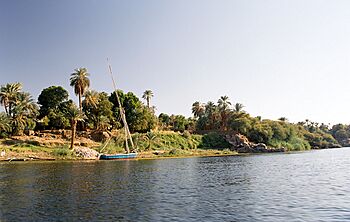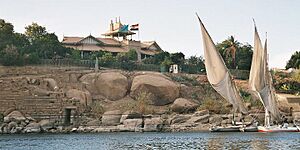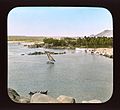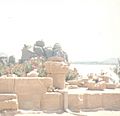Elephantine facts for kids
|
Native name:
جزيرة فيلة
(Ⲉ)ⲓⲏⲃ 𓍋𓃀𓅱𓃰 |
|
|---|---|

West bank of Elephantine Island on the Nile
|
|
| Lua error in Module:Location_map at line 416: Malformed coordinates value. | |
| Geography | |
| Coordinates | Lua error in Module:Coordinates at line 614: attempt to index field 'wikibase' (a nil value). |
| Adjacent bodies of water | Nile |
| Length | 1,200 m (3,900 ft) |
| Width | 400 m (1,300 ft) |
| Administration | |
|
Egypt
|
|
Elephantine Island is a cool island located in the Nile River. It's part of the city of Aswan in Upper Egypt. Imagine a place where ancient history comes alive! This island is so important that its ancient ruins became a World Heritage Site in 1979. It's recognized along with other amazing historical places in Upper Egypt.
Scientists and archaeologists have learned a lot about life on Elephantine Island in ancient Egypt. They've found old writings on papyrus and ostraca (pieces of pottery used for writing). These findings tell us about the gods worshipped there and even about a Jewish community that lived on the island.
Contents
Where is Elephantine Island?
Elephantine Island, which ancient Egyptians called Yebu or Abu, is at the very top part of the Nile River. It's located in Aswan, a city in southern Egypt. This island was once the capital of the first "nome" (like a province) in ancient Upper Egypt.
The island is about 1,200 meters (almost a mile) long from north to south. It's about 400 meters (a quarter-mile) wide at its widest point. You can see how the island is shaped from the hills along the Nile's west bank. It sits just below the First Cataract, which is a rocky part of the river. This spot was the southern border of Upper Egypt, right next to Lower Nubia. The area is called Upper Egypt because it's further upstream on the Nile.
Why is it called Elephantine? Some people think it's because the island looks like an elephant tusk from above. Others believe it's named after the rounded rocks along its banks, which look a bit like elephants.
Life in Ancient Egypt
To the ancient Egyptians, this island was known as ꜣbw, meaning "Elephant." It was a very important place because it sat right on the border between Egypt and Nubia. This made it a perfect spot for trade. Goods like ivory, which was very valuable, would pass through Elephantine.
The island was also a great place for a fort because it was easy to defend. Its location made it a natural stop for boats trading along the river. During a time called the Second Intermediate Period (around 1650–1550 BC), the fort on Elephantine marked Egypt's southern border. The island was also a key quarry, providing granite for building huge monuments all over Egypt.
Ancient texts from the Middle Kingdom of Egypt mention that the mother of Amenemhat I, a pharaoh who started the Twelfth Dynasty, came from the Elephantine region. Many historians think this means Amenemhat I's mother might have been from Nubia.
Archaeological Discoveries
Between 1893 and 1910, many ancient writings on papyrus were found on Elephantine. These writings, called Aramaic papyri, included details about the Jewish people living there. German archaeologists have done a lot of digging on the island, finding many papyri and ostraca. These discoveries have taught us a lot about the Jewish community's life and importance on Elephantine.
French teams also explored the island and found hundreds of ostraca. Most of the major findings from the late 1800s and early 1900s are now in museums. You can see them in Berlin, Brooklyn, Cairo, London, Munich, and Paris.
Today, the German Archaeological Institute continues to dig on the island. They've found many amazing things, which you can see at the Aswan Museum on the island. One cool discovery was a mummified ram, which was sacred to the god Khnum. Even older artifacts from before the time of the pharaohs have been found here. A rare calendar, called the Elephantine Calendar of Things, was also found in pieces. It dates back to the time of Thutmose III (around 1479–1425 BC).
Ancient Temples
Before 1822, there were temples dedicated to pharaohs like Thutmose III and Amenhotep III on the island. Sadly, these temples were destroyed in 1822 during a military campaign by Muhammad Ali of Egypt.
The two most important temples on the island were for the goddesses Satet and Khnum. The temple of Satet was built around 3000 BC. It was made bigger and improved over the next 3,000 years! There are also records of an Egyptian temple for Khnum on the island from as early as the Third Dynasty of Egypt. This temple was completely rebuilt much later, during the Thirtieth Dynasty of Egypt. The Greeks, who ruled Egypt for about 300 years (305–30 BC), kept the ancient Egyptian religious traditions alive. They often linked Egyptian gods with their own.

Today, most of the southern part of the island is covered by the ruins of Khnum's temple. These are the oldest ruins still standing on the island. They include a granite step pyramid from the Third Dynasty and a small temple built for a local ruler named Heqaib from the Sixth Dynasty of Egypt. Later, during the Middle Kingdom, many important officials built statues and shrines in the temple.
Nilometers: Measuring the Nile
A nilometer was a special structure used to measure how clear the Nile River was. It also measured the water level during the yearly flood season. These measurements were very important for farming and predicting harvests. Elephantine Island has two nilometers.
The most famous one is a long corridor with a stone staircase that goes down to the river. It's connected to the temple of Satet. This is one of the oldest nilometers in Egypt. It was rebuilt during Roman times and was still used as late as the 1800s! There are 90 steps leading down to the river, marked with Arabic, Roman, and hieroglyphic numbers. You can still see ancient carvings from the Seventeenth Dynasty of Egypt at the water's edge.
The other nilometer is a rectangular pool at the southern tip of the island, near Khnum's temple. It's probably even older than the first one. The Greek historian Strabo mentioned one of the nilometers, but it's not clear which one.
Some stories say that the famous "Well of Eratosthenes" was on the island. This well was supposedly used by Eratosthenes to calculate the Earth's circumference. However, Strabo's writings suggest the well was in Aswan, not on Elephantine. Neither nilometer on the island would have worked for that purpose.
The Elephantine Triad: Gods of the Nile
The "Elephantine triad" refers to three important gods worshipped on the island: Khnum, Satet, and Anuket. It's debated whether Anuket was the daughter of Khnum and Satet, or Satet's sister.
- Khnum was the ram-headed god of the cataracts (rocky rapids). People believed he guarded and controlled the Nile's waters from caves under the island. Later, his role changed, and he became known as a potter god who created human bodies.
- Satet was worshipped from very early times as a war goddess and protector of this important region. She was also seen as a fertility goddess who brought the Nile's yearly flood, which made the land fertile. Her worship started in Aswan.
- Anuket was the goddess of the first cataract and was seen as the spirit of the Nile itself. A special worship group was formed for her on the island.
Jewish Community on the Island
The Elephantine papyri and ostraca are collections of old legal documents and letters written in Aramaic. They date back to the 5th century BC. These writings show that a community of Judean soldiers and their families lived on Elephantine Island starting in the 7th century BCE. These soldiers guarded the border between Egypt and Nubia.
After the destruction of Jerusalem in 587 BC, some Judean refugees traveled south and settled on Elephantine. They had their own temple, called the House of Yahweh, where they offered sacrifices. This temple existed alongside the temple of Khnum. It's not fully clear when or why the Jewish community settled on Elephantine. Their temple might have been built because of changes in worship back home, or simply to meet the needs of the Jewish people living there.
Challenges for the Jewish Community
While there was often cultural exchange between the Jewish and Egyptian people on Elephantine, there were also times of conflict. The earliest mention of the Jewish temple is from 525 BC. In 410 BC, the Jewish temple, the House of Yahweh, was burned down. This happened after a Persian military leader was paid by the priests of Khnum.
Even though the exact reason isn't clear, it's thought that the Khnum priests were upset by the Jewish practice of sacrificing sheep, especially during Passover. Old records from this time show Jewish letters asking for help to rebuild their temple.
What Else Can You See?
The Aswan Museum is located at the southern end of Elephantine Island. It displays many of the amazing things found during archaeological digs, including the mummified ram of Khnum.
A large number of Nubians (people from the region of Nubia) live in three villages in the middle of the island. There's also a big luxury hotel at the northern end of the island.
Right next to Elephantine, to the west, is el Nabatat Island, which is home to the beautiful Aswan Botanical Garden.
Images for kids
-
Votive naos with sledge and pronaos supported by hathoric columns, dedicated by the artisan Kasa to the Elephantine Triad. Museo Egizio, Turin.
-
Nubian houses on central Elephantine Island
-
Verdant Elephantine Island, opposite Assuan, Egypt", 1908. Lantern slide. Brooklyn Museum
-
Island of Elephantine, by Edwin Howland Blashfield. Brooklyn Museum
See also
 In Spanish: Elefantina para niños
In Spanish: Elefantina para niños










